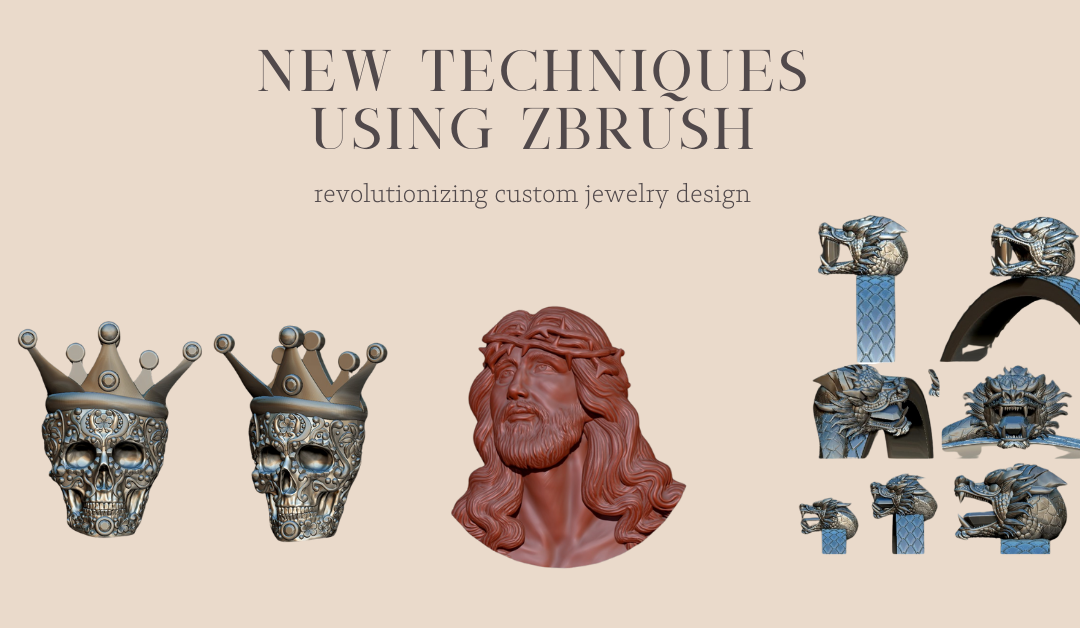
New Techniques Using ZBrush for Jewelry Design: Revolutionizing Custom Jewelry Creation
In the ever-evolving world of jewelry design, the integration of advanced software has significantly transformed the creative process. Among these groundbreaking tools, ZBrush stands out, particularly for its capabilities in custom design, jewelry CAD, and the production of custom jewelry. This blog delves into how ZBrush is revolutionizing the custom jewelry industry, offering designers unparalleled flexibility and precision.
The Power of ZBrush in Custom Jewelry Design
ZBrush, a digital sculpting tool, is renowned for its ability to handle high-resolution models with intricate details, making it an ideal choice for jewelry design. Its versatility allows designers to create complex and organic shapes that were previously difficult to achieve using traditional CAD software. Here’s how ZBrush is changing the landscape of custom jewelry:
1. Unmatched Detail and Precision
One of the standout features of ZBrush is its ability to produce incredibly detailed models. For custom jewelry, where precision and intricacy are paramount, ZBrush’s capabilities are unparalleled. Designers can sculpt minute details, such as delicate filigree work or intricate patterns, directly into their models, ensuring that every piece is unique and meticulously crafted.
2. Enhanced Creative Freedom
ZBrush offers a level of creative freedom that is hard to match. Its intuitive interface and powerful sculpting tools allow designers to experiment with different shapes, textures, and designs without the limitations imposed by traditional CAD software. This freedom enables the creation of truly bespoke pieces that cater to the individual tastes and preferences of clients.
3. Efficient Workflow Integration
ZBrush seamlessly integrates with other jewelry CAD software, streamlining the design process. Designers can import and export files between ZBrush and other CAD programs, facilitating a smooth transition from initial concept to final production. This integration ensures that the design process is efficient and that the final product meets the highest standards of quality.
Techniques for Using ZBrush in Custom Jewelry Design
To harness the full potential of ZBrush in custom jewelry creation, designers can employ various techniques that enhance the design process and the final product’s quality:
1. Dynamic Subdivision and Sculpting
Dynamic subdivision allows designers to add layers of detail to their models without affecting the overall mesh structure. This technique is particularly useful for creating complex surface details, such as engravings or embossed patterns, which are essential for custom jewelry.
2. IMM (Insert Multi Mesh) Brushes
ZBrush’s IMM brushes enable designers to insert pre-made components into their models, such as gemstones or prongs. This feature speeds up the design process and ensures that these elements are accurately placed, enhancing the overall aesthetic and functionality of the piece.
3. Alpha and Texture Maps
Using alpha and texture maps in ZBrush allows designers to apply intricate patterns and textures to their models quickly. This technique is invaluable for adding detailed surface finishes, such as wood grain or leather textures, which can add a unique touch to custom jewelry pieces.
Real-World Applications and Benefits
The integration of ZBrush into custom jewelry design has yielded impressive results across the industry. Here are a few examples of how designers are leveraging ZBrush to create stunning custom pieces:
- Bespoke Engagement Rings: Designers use ZBrush to craft one-of-a-kind engagement rings that reflect the personal style and preferences of the couple, incorporating intricate details and unique motifs that are impossible to achieve with traditional methods.
- Artistic Jewelry Collections: Artists and designers can explore new creative avenues by experimenting with unconventional shapes and textures, resulting in jewelry collections that stand out in the market.
- Replicating Historical Designs: ZBrush allows for the accurate replication of historical jewelry designs, preserving the intricate details and craftsmanship of antique pieces while adapting them for modern production techniques.
We at Jewelry Cad on Demand have been using ZBrush based modelling since several years to achieve complex surface modelling that are otherwise almost impossible to achieve. With ZBrush, you can make models that involve human faces, animal figurines, complex textures and several other organic shapes. Some of our models sculpted on ZBrush have won prestigious awards in different competitions too.

